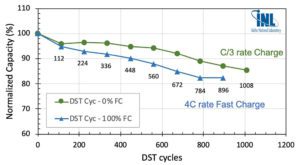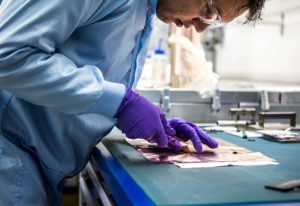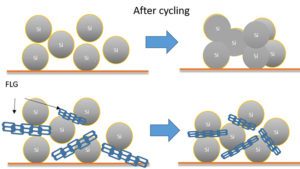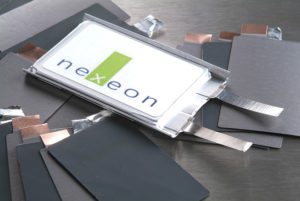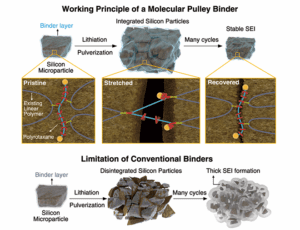Idaho National Laboratory (INL) has successfully tested over 1,000 charge-discharge cycles using high-energy silicon anode pouch cells made by Zenlabs Energy. Zenlabs received a $4.8-million, 50% cost-share development contract from the United States Advanced Battery Consortium (USABC) to develop low-cost, fast-charge EV batteries. As a part of the USABC program, Zenlabs delivered its 12 Ah… Read more »
Search Results Found For: "silicon anodes"
DOE selects Enovix for advanced silicon-based anode research funding
The DOE has announced FY2020 federal funding for projects that support new and innovative advanced vehicle technologies. Enovix has been selected to advance R&D on lithium-ion batteries using silicon-based anodes. The selection, recommended by the Vehicle Technologies Office, authorizes Enovix to complete negotiations for a $3.2-million federal award funded through the DOE’s Office of Energy… Read more »
LeydenJar says its silicon anode boosts battery energy density by 70%
LeydenJar Technologies, a Dutch spinoff of the applied research institute TNO, has developed a new battery anode that’s made from 100% silicon. The company says this provides two key benefits: batteries with a 70% higher energy density (1,350 Wh/L) and 62% lower CO2 emissions than current models. The anode is ready for production, and LeydenJar… Read more »
Enevate says its silicon-dominant anode technology is ready for EV production
Q&A with Enevate’s Founder and CTO Dr. Benjamin Park Introducing silicon into automotive-grade lithium-ion cells has been a major topic in the EV industry in the past decade. Silicon is widely considered to be the next big thing in anode technology, because it has a theoretical charge capacity ten times higher than that of typical graphite anodes…. Read more »
Wildcat Discovery Technologies receives second patent for silicon anode electrolytes
Wildcat Discovery Technologies, a company that uses high-throughput methods to develop next-generation battery materials, has received a second patent on its development of electrolytes for silicon anode batteries. Wildcat’s first patent for this work was awarded in late 2018 and covered the use of sulfolane-based electrolytes. This new patent covers acrylate-based additives which can be… Read more »
Amprius’s silicon nanowire batteries power the Zephyr S HAPS solar aircraft
Battery manufacturer Amprius is supplying lithium-ion cells to Airbus’s Zephyr program. Using Amprius’s cells, which contain a 100% silicon anode, the Zephyr S solar-powered unmanned aerial vehicle (UAV) recently flew more than 25 days, setting a new record for stratospheric flight. The Zephyr S is a high-altitude pseudo-satellite (HAPS), which combines the persistence of a… Read more »
Adding graphene girders to silicon electrodes could double battery life
Graphite has long been the default choice of material for anodes, but researchers dream of replacing graphite with silicon, which has ten times the gravimetric energy density. Unfortunately, silicon has several issues that limit its commercial use – it expands during lithiation, causing particles to agglomerate in ways that impede efficiency, and it is not… Read more »
Nexeon and partners win £7 million in funding to develop silicon anode tech
Silicon anode specialist Nexeon, along with a couple of partners, has been awarded £7 million in Innovate UK funding for the SUNRISE project, which will develop battery materials based on silicon as a replacement for carbon in the cell anode Nexeon will lead the silicon material development and scale-up stages of the project, while polymer… Read more »
Molecular pulley leads to silicon anode breakthrough
Silicon anodes are receiving a great deal of attention, as they can enable batteries to deliver 3-5 times higher capacities compared with current graphite anodes. Although silicon is abundant and cheap, Si anodes have a limited number of charge-discharge cycles – typically less than 100 times. Their volume expands enormously during each cycle, leading to… Read more »
3M sells NMC cathode patents to Umicore, will focus on Si anodes
3M has agreed to transfer all of its intellectual property related to Nickel-Manganese-Cobalt (NMC) cathodes, including global patents and license agreements, to technology and recycling firm Umicore. The divestment will allow 3M to increase its focus on next-generation silicon anode materials, electrolyte additives and advanced thermal management solutions for EVs. “The agreement enables 3M to… Read more »




